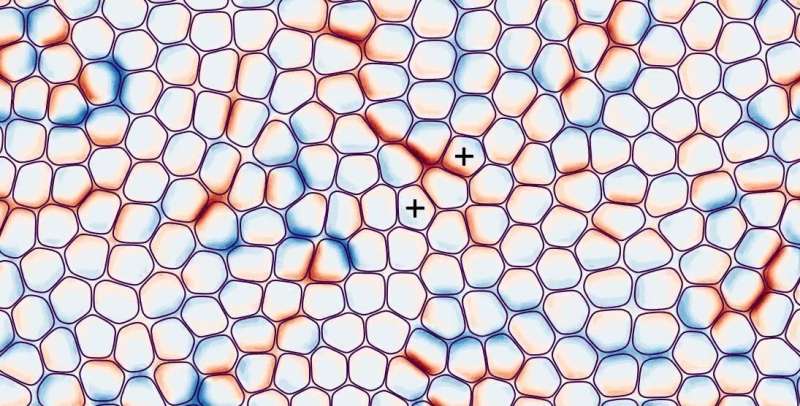This article has been reviewed according to Science X's editorial process and policies. Editors have highlighted the following attributes while ensuring the content's credibility:
fact-checked
peer-reviewed publication
trusted source
proofread
Condensed matter physics inspires a new model of cellular behavior

Cells are expert cooperators and collaborators. To maintain tissue health, cells talk to each other, exert pressure on each other, and kick out cells that are not contributing to the overall well-being of the collective. When it's time to get rid of a cell, the collective group initiates a process called cell extrusion. Cells can be extruded for a number of reasons—they could be cancerous, or old, or they simply could be overcrowding other cells. Extrusion is a necessary process for tissues to maintain health and integrity.
Biologists have long studied the biochemical cues and signals that underly cell extrusion, but the mechanical, physical forces involved are poorly understood.
Now, inspired by the mechanics of a phase of matter called liquid crystals, researchers have developed the first three-dimensional model of a layer of cells and the extrusion behavior that emerges from their physical interactions. From this new model, the team discovered that the more a cell is squeezed by its neighbors in a particular symmetric way, the more likely it is to get extruded from the group.
The model and findings are described in a paper titled "Mechanical Basis and Topological Routes to Cell Elimination" published in the journal eLife. The work was a collaboration between the laboratories of Guruswami Ravichandran, the John E. Goode, Jr., Professor of Aerospace and Mechanical Engineering; José Andrade, the George W. Housner Professor of Civil and Mechanical Engineering; and the Niels Bohr Institute in Copenhagen, Denmark.
A liquid crystal is a phase of matter that is in between a solid and a liquid. Like a solid, the liquid crystal substance resists deformation, but like a traditional liquid, the molecules that make up the substance can flow around. The study of liquid crystals has traditionally been within the field of condensed matter physics, but in the last six years, it has been used to describe the behavior of living cells.
"The most exciting part of this study is that we are just scratching the surface of combining these fields," says Siavash Monfared, a former postdoctoral scholar at Caltech and the study's first author. "What's very challenging about biology is that living systems are active and out of equilibrium, whereas physics and mechanics are often based around thermodynamic equilibrium. The study of active matter has a lot of promise for using physics and physical forces to understand biological systems."
In this new work, the team modeled a single layer of cells, incorporating principles of liquid crystal physics. The cells are modeled as active and deformable spherical droplets, packed in closely together in the way that real cells form a tissue, and set atop a substrate. The researchers then were able to tweak a parameter called adhesion, a measure of how strongly the cells stuck to one another or the substrate, and observe how extrusion behavior was affected.
Though the molecules in a liquid crystal can flow freely, they are known to display certain types of symmetry. One of these is called hexatic symmetry, which is a sixfold hexagonal rotational symmetry. The model showed that as cell adhesion increased, the collective group was likely to extrude any cells that broke with hexatic symmetry.
"Behaviors like extrusion emerge from collective interactions—cells pushing on each other, deforming, rotating, and so on," says Monfared, who is now a postdoctoral scholar at the Niels Bohr Institute in Copenhagen, Denmark. "The ultimate goal is to understand how mechanical forces interact with biochemical signals. The two-way communication between mechanical and biochemical signals is an active, and intense, area of research."
More information: Siavash Monfared et al, Mechanical basis and topological routes to cell elimination, eLife (2023). DOI: 10.7554/eLife.82435
Journal information: eLife
Provided by California Institute of Technology




















